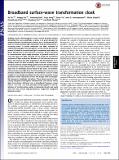Broadband surface-wave transformation cloak
Author(s)
Xu, Su; Xu, Hongyi; Gao, Hanhong; Jiang, Yuyu; Yu, Faxin; Joannopoulos, John D.; Chen, Hongsheng; Sun, Handong; Zhang, Baile; Soljacic, Marin; ... Show more Show less
DownloadXu-2015-Broadband surface-wa.pdf (1.175Mb)
PUBLISHER_POLICY
Publisher Policy
Article is made available in accordance with the publisher's policy and may be subject to US copyright law. Please refer to the publisher's site for terms of use.
Terms of use
Metadata
Show full item recordAbstract
Guiding surface electromagnetic waves around disorder without disturbing the wave amplitude or phase is in great demand for modern photonic and plasmonic devices, but is fundamentally difficult to realize because light momentum must be conserved in a scattering event. A partial realization has been achieved by exploiting topological electromagnetic surface states, but this approach is limited to narrow-band light transmission and subject to phase disturbances in the presence of disorder. Recent advances in transformation optics apply principles of general relativity to curve the space for light, allowing one to match the momentum and phase of light around any disorder as if that disorder were not there. This feature has been exploited in the development of invisibility cloaks. An ideal invisibility cloak, however, would require the phase velocity of light being guided around the cloaked object to exceed the vacuum speed of light—a feat potentially achievable only over an extremely narrow band. In this work, we theoretically and experimentally show that the bottlenecks encountered in previous studies can be overcome. We introduce a class of cloaks capable of remarkable broadband surface electromagnetic waves guidance around ultrasharp corners and bumps with no perceptible changes in amplitude and phase. These cloaks consist of specifically designed nonmagnetic metamaterials and achieve nearly ideal transmission efficiency over a broadband frequency range from 0+ to 6 GHz. This work provides strong support for the application of transformation optics to plasmonic circuits and could pave the way toward high-performance, large-scale integrated photonic circuits.
Date issued
2015-06Department
Massachusetts Institute of Technology. Institute for Soldier Nanotechnologies; Massachusetts Institute of Technology. Department of Electrical Engineering and Computer Science; Massachusetts Institute of Technology. Department of Physics; Massachusetts Institute of Technology. Research Laboratory of ElectronicsJournal
Proceedings of the National Academy of Sciences
Publisher
National Academy of Sciences (U.S.)
Citation
Xu, Su, Hongyi Xu, Hanhong Gao, Yuyu Jiang, Faxin Yu, John D. Joannopoulos, Marin Soljačić, Hongsheng Chen, Handong Sun, and Baile Zhang. “Broadband Surface-Wave Transformation Cloak.” Proc Natl Acad Sci USA 112, no. 25 (June 8, 2015): 7635–7638.
Version: Final published version
ISSN
0027-8424
1091-6490